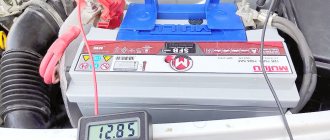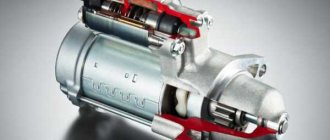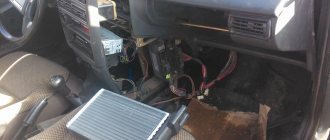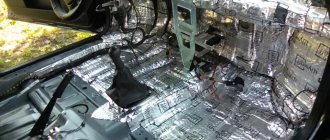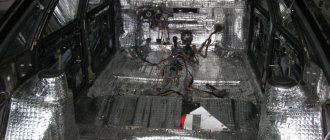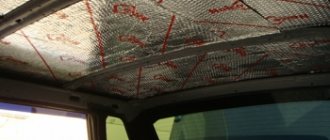Winter is the most unfavorable time of year for operating a car. This is primarily due to starting problems and prolonged warm-up of the engine.
But the dilemma can be easily resolved if certain measures are taken.
Below we consider the most important questions:
- How to insulate a car hood?
- What are the pros and cons of a car blanket, and how to use it correctly?
- What materials are used for thermal insulation?
- Why and how to close the radiator grille for the winter?
Let's consider each of the questions in detail.
Methods for insulating the hood
Many car owners are interested in what is the point of insulating the hood, because the manufacturer has already provided the necessary protection.
In fact, this is not enough. Additional protection is required to solve the following problems:
- Accelerate engine warm-up and reduce fuel consumption;
- Eliminates the appearance of ice on the surface of the hood, which negatively affects the paintwork of the car.
How to insulate the hood of a car and the engine compartment as a whole? The car owner has the following options at his disposal:
Buying a car kit for a motor.
This method of insulation has been known for several decades. The only thing is that our grandfathers used ordinary blankets.
Today everything is simpler, because there are specialized products on sale that can withstand high temperatures.
The advantages of a car blanket include high efficiency and safety in operation.
In practice, the warm-up time is reduced from 15 to 7-10 minutes, which saves fuel and extends engine life.
In addition, the use of a car blanket allows you to retain heat in the engine compartment longer after stopping.
If there is no blanket, the power unit cools down within 40-50 minutes. The use of insulation extends this period to four to six hours.
This feature is a big bonus for car owners who travel frequently.
Thermal insulation of the hood using special materials (this will be discussed below).
Many manufacturers have already provided noise and heat insulation on the inside of the lid.
But to increase efficiency, it is worth improving it yourself, without throwing away the factory protection.
Closing the radiator grille.
While driving, large volumes of cold air enter the engine compartment, which impairs the process of warming up the engine to the optimal temperature. One way to solve the problem is to close the grille.
This option can hardly be called ideal from an aesthetic standpoint, but it works.
In addition, it is recommended to provide motor protection to prevent precious heat from escaping through the lower part of the car.
Why did they even come up with insulating the engine compartment?
Motorists note that in winter it is much more difficult to start the engine. Starting a cold engine is a blow to its life. And everything happens like this because in extreme cold the physical properties of oils and fuel in the car’s systems change.
Frost causes the lubricant to thicken and stop penetrating into hard-to-reach corners of the engine. Lack of lubrication negatively affects the stable operation of the engine. The piston group and cylinders will first feel that there is not enough lubrication. The so-called oil starvation causes the pistons to move “dry”. You can’t save on insulation so that you don’t have to bite yourself later.
In addition, you can insulate the hood of your Lada for only 1000 rubles. It will be much cheaper to buy and install insulation on the hood than to carry out a major overhaul of the internal combustion engine. It should also be noted that when fuel freezes, just like lubricant, it changes its physical properties. Frozen fuel practically does not evaporate, which worsens the rich mixture. In winter, the battery suffers no less. The charge is already more difficult to release. Even poured special oil, which, as a rule, should help with starting, will do nothing in severe frosts.
Car products that the market offers
Today, there are several types of engine blankets that differ in material, characteristics and dimensions.
When choosing a product, you should focus on the following parameters:
- Car make (dimensions depend on this);
- Width;
- length;
- Weight;
- The presence of a cutout for a lock;
- Operating temperature requirements;
- Price.
Let's look at the main options:
Car blanket brand A-1.
This insulation is enough to keep the engine warm. The product is manufactured using the best materials, using modern technology and taking into account current standards.
Car blankets are resistant to chemical influences, the passage of electric current and excessive heat.
The operating temperature of A-1 brand products is in the range of -60 ... +650 degrees Celsius. At the same time, the covering material can withstand temperatures up to 650 degrees Celsius, and the blanket filler can withstand temperatures up to 1200 C.
This type of product is suitable for thermal insulation of gasoline and diesel engines.
Thanks to its dielectric properties, you don’t have to worry about accidentally shorting the terminals to the battery.
An important point is the size and the presence of special cutouts. That is why the choice of blanket should be made taking into account the model and make of the car.
Car blanket brand A-2.
Like the previous model, this is a universal product designed for insulation of various types of engines (running on gasoline or diesel).
The use of such a blanket in winter ensures quick warm-up of the engine, increases the service life of the battery and engine, and reduces fuel consumption.
Thanks to its resistance to negative influences (alkalies, acids, high temperatures), the car blanket can last for more than one year.
The main difference is the ability to work in a wide range of temperatures - from 60 degrees below zero to 1200 degrees Celsius.
A blanket of this brand is a dielectric, so touching the battery terminals does not lead to a short circuit.
Scope of application - insulation of engines of any equipment where internal combustion engines are installed.
The insulation contains the following materials:
- Silica tissue;
- Fiberglass threads;
- Mullite-silica wool.
Thanks to this composition, effective thermal insulation of the hood is ensured while retaining heat in the engine compartment.
The main advantages of a car blanket:
- Ability to withstand temperatures up to 1200 degrees Celsius;
- Long-term retention of engine heat;
- Non-flammable;
- Protection of the hood from ice formation.
There are many other modifications of car engine blankets. As a rule, the material from which they are made is the same, the only difference is in size and shape.
We draw a conclusion
With such seemingly inexpensive and easy-to-maintain things, you can thoroughly prepare for the coming winter, which comes unnoticed. No need to wait for the first frost. You need to immediately buy the necessary materials and make patterns. Or there is an option to use standard insulation.
Thanks to this improvement, the power unit will operate more efficiently. In addition, the likelihood of breakdown, in this case, will be much reduced. Good insulation of the engine compartment will improve engine performance and also reduce fuel consumption to autumn levels. Very frequent and sharp temperature changes will not occur, which will greatly delay the process of “overhauling” the power unit. The article describes well all possible insulation for the hood, so after reading the article, everyone should learn a worthy lesson.
Advantages and disadvantages of car blankets
The best indicator of the quality of any product is reviews from real car owners. Car blankets are no exception.
Let's consider what good and bad users identified during operation.
Positive reviews:
- “Since I started using the car blanket, the car has warmed up faster, and the ice on the hood has disappeared. I also operated the car at temperatures below -35 degrees Celsius, so the use of such a product was 100% justified. I’m thinking of additionally insulating the engine compartment at the front and bottom.” Stas, 35 years old .
- “I used a car blanket on two cars and noticed that after turning off the ignition, the engine stays warm longer (on average by 20-30%).” Igor, 46 years old .
- “I’ve been using the car blanket for a month now and I’m pleasantly surprised by the results. The engine heats up faster, the interior warms up better, and fuel consumption has noticeably decreased. All this indicates excellent thermal insulation.” Nikolay, 28 years old .
Among the advantages it is also worth highlighting:
- High quality material;
- Additional sound insulation;
- Strength;
- High quality tailoring.
In addition to positive ones, you can also find negative reviews. Here are some of them:
- “I think I threw money away. The engine still takes longer to warm up than I expected, and cools down a little slower. You could just as easily insulate the hood with paper.” Evgeniy, 45 years old .
- “I recently read that using such a product can lead to lung cancer. The reason is that air passing through this material enters the car interior. So you should think several times whether to buy a blanket or not.” Dmitry, 34 years old .
- “After two months of use, I discovered a number of shortcomings - poor quality of tailoring, lack of proper efficiency and susceptibility to the negative effects of acids (after such liquids come into contact with the surface, the material is corroded). In the future, I plan to insulate the engine compartment using more radical methods.” Evgeniy, 44 years old .
Also the disadvantages include:
- High cost;
- Small thickness at the joints;
- Low efficiency (if installed incorrectly);
- Installation problems.
What does thermal insulation do for a car?
Why does the alternator belt whistle when cold or hot and what needs to be done?
Insulating a car is not just a fashionable trend, as many car owners believe. The use of various materials with high thermal insulation properties allows:
- increase the degree of sound insulation in the cabin;
- reduce heat loss from the passenger compartment when parked in a cold room or in the open air;
- ensure quick engine start;
- reduce fuel consumption for warming up;
- increase the efficiency of the heating system.
Also, insulating the car allows you to avoid the formation of condensation inside the cabin and prevents the occurrence of such an unpleasant phenomenon as ice crust.
A car, the thermal insulation of which is taken care of by its owner, receives an additional advantage in the form of absence of vibration when driving on uneven roads, and the driver and passengers forever forget about the rattling sound from loosely fastened parts.
The process of insulating the hood using a car blanket
It was noted above that the easiest way to insulate the hood of a car is to use a car blanket.
If you choose the right product, it will ideally fit the dimensions of the engine compartment, and its installation will take a minimum of time.
All that is required is to throw a blanket over the engine and seal it around the perimeter. The main thing is that after installation there are no gaps left.
Work order
Insulation for the engine and car body is installed using improvised means as follows:
- cut out a pattern from cardboard or a piece of wallpaper;
- Using special auto clips, secure the pattern to the hood and give it its final shape. Be sure to mark the protrusions for the ribs - two layers of material can be installed there;
- attach the pattern to felt or other insulating material and cut out the hood insulation blank;
- connect the components of the future hood insulation;
- mark and cut out the clip holes in the felt so that they match the similar holes on the body;
- Using clips, secure the felt blank and cut off the excess.
Many people believe that the best material for engine insulation is felt
. See also:
Carbon fiber car hood wrap
Alternative materials for hood insulation
In addition to the considered option, for thermal insulation of the engine you can use:
- Izolon . The advantage is effective heat retention and an affordable price. One square meter costs from 50 to 200 rubles (the price directly depends on the thickness). Advantages: reliable heat retention and high quality.
- Tiviplen-P is a thermal insulation material that has a self-adhesive base. The main component is polyethylene foam. Moreover, the product itself consists of three layers - glue, polyethylene foam, exterior finishing. There is no foil here, but despite this, the product does an excellent job of retaining heat. The thickness of Tiviplena-P is four, eight or fifteen millimeters. Cost - from 220 rubles and above.
- Isoflex. When you need to insulate a car hood, this material comes in handy. Its advantages are double efficiency (sound and thermal insulation). On average, when purchasing such material you will have to pay 60-80 rubles per “square”.
- Stizol or Isoton — universal materials for heat and sound insulation. Sold in small pieces. One sheet costs 1700-2000 rubles.
- Felt . This is the simplest option that does not involve large costs.
How and with what to cover a car’s gasoline engine in winter without the help of a car service
Low temperatures also negatively affect the performance characteristics of a gasoline engine, as well as a diesel unit.
The first step is to pay attention to the thermal insulation of the radiator, for which you can use ordinary cardboard if you don’t want to bother too much. Aesthetes, of course, will prefer to either order a special cover from a sewing workshop using proven patterns, or buy a finished industrial product
They are usually made of artificial leather and insulation. The design of most samples includes valves that can be opened when the temperature rises, which will prevent the motor from overheating.
If the factory version of the car model does not provide thermal insulation for the hood, then this will have to be done separately. You can independently organize such insulation using felt, foiled polypropylene or mineral wool. Having decided the question of how to cover a car’s gasoline engine in winter, it is additionally recommended to protect its lower part. The technology for thermal insulation of the lower area of the internal combustion engine is as follows:
- Remove the crankcase protection and clean its surface from dirt and oil stains.
- Cut the thermal insulation to the size of the protection and secure it with glue or double-sided tape. The dimensions of the insulation should be 10-20 mm larger than the protective plate in order to cover the attachment points.
- Degrease the crankcase, cut out the foam insulation according to the pattern, and glue it to the crankcase.
- Cover the side surfaces of the engine compartment with thermofoil.
On some cars with high ground clearance, the insulation can be secured to the protection using gazelle clips. To do this, 4 holes of the appropriate diameter are drilled along the bumper, after which the insulation is fixed through them. Next, it is attached with clips through the drainage holes to the suspension arms and side members.
Do-it-yourself hood insulation
Thermal insulation of the hood is a labor-intensive process that requires the use of high-quality materials and strict adherence to the installation algorithm. The first step is to select the appropriate material.
To insulate the hood, you can use the following options (except for those already described above):
1. Without foil coating:
- PPE NH - heat and noise insulation material based on polyethylene. The product is distinguished by its affordable price, excellent performance characteristics, ability to retain heat and suppress unnecessary noise. It is used for thermal insulation of the hood, floor, luggage compartment, doors and other things.
- Splen 3004 is an affordable option that allows you to solve two problems at once (provide sound and thermal insulation). The peculiarity of splen is the presence of an adhesive layer, ease of installation and the absence of the need to additionally heat the product. Splen 3004 has a fine structure and is made using polyethylene. Dimensions (width, length) - 1,000 and 20 mm, respectively. The thickness is selected taking into account the tasks.
- Ultimate Soft Gray is a foam rubber that has decent performance and a low price. It is used to provide heat and sound insulation of doors, trunk, floor and engine compartment. Roll parameters (width, length) - 500, 750 mm, respectively.
2. With foil:
- Ultimate Soft Gray with foil. A special feature is the presence of a thin layer of foil on the surface. The product is resistant to high temperatures and is suitable for heat and sound insulation of various parts of the machine. With its help, it is easy to insulate the car hood, luggage compartment, roof, doors and other elements of the car. The length of the material is 750 mm, the width and thickness are 500 and 10 mm, respectively (the latter parameter may vary).
- NPE - polyethylene foam, covered with a thin layer of foil on top. This combination provides powerful thermal insulation. In recent years, this material has been increasingly used in the organization of hood thermal insulation. Advantages: high quality, low price. Available in white and gray colors in rolls of 50 meters long and 100 cm wide. Thickness may vary.
- Isolontape 300 LA - characterized by the presence of a self-adhesive layer, as well as the ability to store heat, retain noise and moisture. Pros: reasonable cost, no odor and hygienic safety. Sold in gray and white, in rolls of thirty meters long and a meter wide. Thickness may vary. It is based on chemically cross-linked polyethylene foam. Often used for hood insulation.
To insulate the hood with your own hands, you should proceed as follows:
1. Prepare the necessary tools and material. To work you will need:
- Stationery knife;
- Scotch;
- Paper;
- Pencil pen);
- Marker;
- Scissors.
2. Make layouts taking into account the sizes of the hood sections. To do this, use cardboard or paper. Here it is important to make the workpieces with precision in order to avoid wasting excess heat-insulating material. As practice shows, to insulate the hood of a car, an average of 0.6-0.7 square meters of insulation is required.
3. Cut out all the blanks and sign with a marker (this will eliminate confusion during installation).
4. Attach the blanks to the heat-insulating material and outline the boundaries with a marker.
5. Carefully cut out the blanks that will later be glued to the hood.
6. Prepare the surface of the metal that is being processed. Wash the inner surface with a soapy solution, then let the surface dry.
7. Treat the metal with a degreaser to eliminate sagging.
8. Apply the prepared pieces to certain areas and stick them. Please note that it is not advisable to insulate the hood with glue. Use products with a ready-made adhesive layer.
If everything is done correctly and consistently, the hood insulation will be ready in 20-30 minutes.
In addition, with the correct choice of materials, it is possible not only to insulate the engine compartment, but also to improve the sound insulation of the car hood.
Sound insulation of cars using building materials. Is this alternative worth using?
- Do not use polyethylene foam for sound absorption. Despite the assurances of sellers, its noise insulation coefficient is highly exaggerated and in reality tends to zero. Rather, it can be attributed to waterproofing;
- You shouldn’t rely on foam rubber either. Its main functions are insulating; besides, it is quite difficult to fix it;
- Do not believe advertisements praising the sound-absorbing qualities of splen. It is expensive, but in fact it is also insulation;
- The use of foam pads under laminate flooring can only be of limited use. Firstly, they are not resistant enough to mechanical stress. Secondly, their moisture resistance is low. If you lay them on the floor in the cabin in the fall/winter/spring, when there is a lot of rainfall, the gaskets will fail within a month. Although insulating the wheel arches in the trunk with them is a completely acceptable idea;
- Felt is an excellent sound insulator. However, it has the unpleasant feature of absorbing water and being reluctant to give it away. If you decide to lay it on the floor, make the mats removable and replaceable - some dry, others work. Or seal it in construction polyethylene. But for insulating the body - doors, roof, etc. - it is suitable without meeting any conditions.
- An ordinary construction waterproofing agent is purchased - a bitumen sheet layered with fiberglass. It will act as a vibration isolator. Standard roll of 10 sq. m is enough to process a car of any size;
- Patterns are made according to the isolated areas, from which blanks are cut;
- The standard casing is removed; if there are rattling objects underneath (there are especially many of them in doors), they are wrapped in rags or electrical tape;
- The surface is degreased with white spirit, and the pattern is glued to it - pressing and smoothing. Glue 88 is ideal for fixation; it bonds the insulator to the metal to death;
- Then, at a minimum, the joints between the plates are glued with Guerlain tape - a product made of butyl rubber with a foil surface;
- It’s better not to be lazy, but to cover the entire insulated area with it: guerlain will make the waterproofing material heavier and increase the degree of vibration absorption. In addition, it does not dry out under the influence of external factors, so it will protect the bitumen layer from destruction. There is no need to worry about the health of the salon’s population: guerlain is harmless and approved for use in residential premises;
- The third layer will be the sound insulator itself. Instead of pure felt, you can buy a carpet made from it with a bitumen coating - this will protect the material from moisture. Using the same patterns, blanks are made and attached on top of the guerlain;
- The hood and trunk lids can be insulated with floor linoleum. You need to take a thick variety that has a waterproof base. Linoleum is glued using automotive bitumen, and foamed polyethylene with a foil layer is glued on top of it. The thickness of the top coating is not less than 5 mm. This insulation option is preferable to others because it does not make the lids too heavy.
AutoFlit.ru
Closing the car grille
The final touch in the matter of thermal insulation is the closing of the radiator grille, through which cold air flows. If nothing is done, insulating the hood will not give much results.
The car owner has several options at his disposal:
- Using ordinary cardboard (this option is often found on Gazelles). For obvious reasons, it is not suitable for passenger cars.
- The use of special radiator grilles in which the blinds are closed (available for some models of foreign cars).
- Preparation and fastening of a suitable piece using foil insulation.
Next, it wouldn’t hurt to soundproof the car’s fender liner.
Salon
After completion of work with insulation of the engine compartment, the next stage is thermal insulation of the car interior.
The goal of the car enthusiast here is clear - to retain heat in the car interior and speed up the heating of the interior by the stove in winter.
This work is relevant not only for cars of the domestic automobile industry (for obvious reasons), but also for foreign cars.
Thanks to high-quality insulation and effective athermal tinting, it is possible to maintain heat in the cabin longer, even without turning on the stove.
At the same time, modern materials provide excellent sound insulation, which provides additional comfort during the trip.
Tests to determine the best insulation
Experts conducted many comparisons in which they determined the best material. The “test subjects” were penofol with applied foil, a special blanket and felt. Also, native Zhiguli insulation materials were added to the competition, but they passed out of the competition, showing not the best results. The measurements were carried out three times. In the first experiment, they measured the period of time during which the engine could warm up to operating temperature. In the second - the time during which the unit cools down. The third test was aimed at determining the degree of ignition. All experiments were carried out at a temperature of -20 degrees.
In the first test, the car was warmed up for 10 minutes. In one case, insulation was installed, and in the second, not. According to the results, it turned out that the motor with the blanket cooled down completely in 6 hours. The standard installation insulation lasted 4 hours. The foil material did not allow the engine to cool for 3.5 hours. This is a good result, since the motor without insulation cooled down in 3 hours. The felt achieved an average result; it cooled for 5 hours. What about the third competition - the best ignition rate for a car blanket. Insulation with applied foil is very cheap, but it also burns very well. If a short circuit occurs, this material will ignite within seconds. In addition, if the foil insulation is installed incorrectly and sagging appears, then the battery terminals can reach the protection and close the circuit.
It is important to know
Before gluing the insulation, you need to clean and degrease the surface. This will ensure that the material does not come off while moving. Now the engine will not be afraid of even the most severe frosts. The car can be operated without fear that the engine will simply need to be warmed up. It is important to note that thanks to this improvement, ice will no longer accumulate on the hood. Plus, all the material is available anywhere. Insulation with foil applied to it is perfect for solving this problem. By the way, this material is very cheap, and its properties are in no way inferior to professional blankets.
Manufacturers
There are only a few manufacturers that supply hood insulation.
is ready to offer technologically advanced hood insulation “Isoflex” and “Tiviplen”.
"TiviplenP" has a self-adhesive layer, and it is made on the basis of polyethylene foam. These are three layers - a layer with glue, polyethylene foam itself and the front side of PVC. There is no foil in this product, but the heat is retained quite effectively. There are several types of product thickness to choose from. You can choose a thickness from four to fifteen millimeters.
As for Isoflex, it is more sound-absorbing and is not suitable for heat preservation. However, thanks to the polyurethane foam layer, it can be used as hood insulation.
offers only thermal insulation products. This company initially set out to create universal solutions. The product not only retains heat well, but also has excellent noise-absorbing properties.
